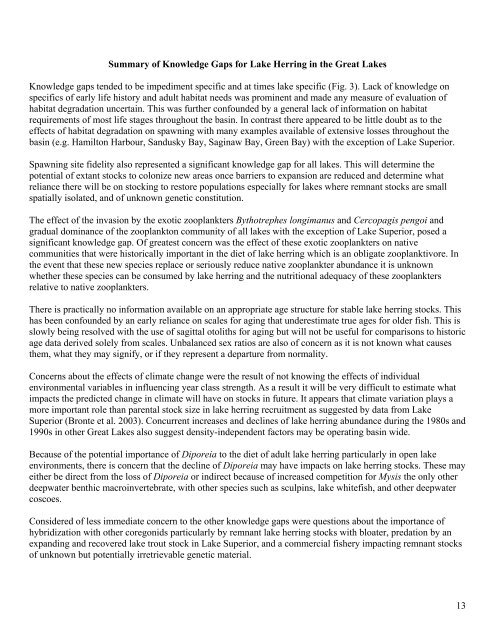Status and assessment, research, and restoration needs for lake ...
Status and assessment, research, and restoration needs for lake ...
Status and assessment, research, and restoration needs for lake ...
You also want an ePaper? Increase the reach of your titles
YUMPU automatically turns print PDFs into web optimized ePapers that Google loves.
Summary of Knowledge Gaps <strong>for</strong> Lake Herring in the Great Lakes<br />
Knowledge gaps tended to be impediment specific <strong>and</strong> at times <strong>lake</strong> specific (Fig. 3). Lack of knowledge on<br />
specifics of early life history <strong>and</strong> adult habitat <strong>needs</strong> was prominent <strong>and</strong> made any measure of evaluation of<br />
habitat degradation uncertain. This was further confounded by a general lack of in<strong>for</strong>mation on habitat<br />
requirements of most life stages throughout the basin. In contrast there appeared to be little doubt as to the<br />
effects of habitat degradation on spawning with many examples available of extensive losses throughout the<br />
basin (e.g. Hamilton Harbour, S<strong>and</strong>usky Bay, Saginaw Bay, Green Bay) with the exception of Lake Superior.<br />
Spawning site fidelity also represented a significant knowledge gap <strong>for</strong> all <strong>lake</strong>s. This will determine the<br />
potential of extant stocks to colonize new areas once barriers to expansion are reduced <strong>and</strong> determine what<br />
reliance there will be on stocking to restore populations especially <strong>for</strong> <strong>lake</strong>s where remnant stocks are small<br />
spatially isolated, <strong>and</strong> of unknown genetic constitution.<br />
The effect of the invasion by the exotic zooplankters Bythotrephes longimanus <strong>and</strong> Cercopagis pengoi <strong>and</strong><br />
gradual dominance of the zooplankton community of all <strong>lake</strong>s with the exception of Lake Superior, posed a<br />
significant knowledge gap. Of greatest concern was the effect of these exotic zooplankters on native<br />
communities that were historically important in the diet of <strong>lake</strong> herring which is an obligate zooplanktivore. In<br />
the event that these new species replace or seriously reduce native zooplankter abundance it is unknown<br />
whether these species can be consumed by <strong>lake</strong> herring <strong>and</strong> the nutritional adequacy of these zooplankters<br />
relative to native zooplankters.<br />
There is practically no in<strong>for</strong>mation available on an appropriate age structure <strong>for</strong> stable <strong>lake</strong> herring stocks. This<br />
has been confounded by an early reliance on scales <strong>for</strong> aging that underestimate true ages <strong>for</strong> older fish. This is<br />
slowly being resolved with the use of sagittal otoliths <strong>for</strong> aging but will not be useful <strong>for</strong> comparisons to historic<br />
age data derived solely from scales. Unbalanced sex ratios are also of concern as it is not known what causes<br />
them, what they may signify, or if they represent a departure from normality.<br />
Concerns about the effects of climate change were the result of not knowing the effects of individual<br />
environmental variables in influencing year class strength. As a result it will be very difficult to estimate what<br />
impacts the predicted change in climate will have on stocks in future. It appears that climate variation plays a<br />
more important role than parental stock size in <strong>lake</strong> herring recruitment as suggested by data from Lake<br />
Superior (Bronte et al. 2003). Concurrent increases <strong>and</strong> declines of <strong>lake</strong> herring abundance during the 1980s <strong>and</strong><br />
1990s in other Great Lakes also suggest density-independent factors may be operating basin wide.<br />
Because of the potential importance of Diporeia to the diet of adult <strong>lake</strong> herring particularly in open <strong>lake</strong><br />
environments, there is concern that the decline of Diporeia may have impacts on <strong>lake</strong> herring stocks. These may<br />
either be direct from the loss of Diporeia or indirect because of increased competition <strong>for</strong> Mysis the only other<br />
deepwater benthic macroinvertebrate, with other species such as sculpins, <strong>lake</strong> whitefish, <strong>and</strong> other deepwater<br />
coscoes.<br />
Considered of less immediate concern to the other knowledge gaps were questions about the importance of<br />
hybridization with other coregonids particularly by remnant <strong>lake</strong> herring stocks with bloater, predation by an<br />
exp<strong>and</strong>ing <strong>and</strong> recovered <strong>lake</strong> trout stock in Lake Superior, <strong>and</strong> a commercial fishery impacting remnant stocks<br />
of unknown but potentially irretrievable genetic material.<br />
13
















